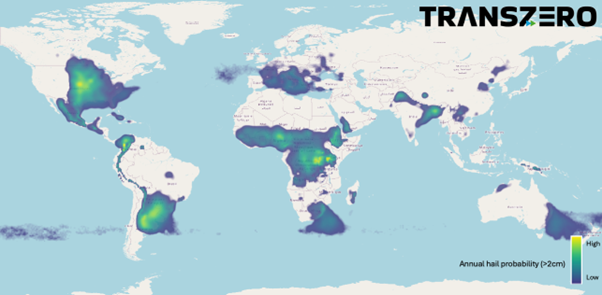Extreme Hail; an emerging threat across Europe
Hailstones occur frequently around the world during large thunderstorms. More recently though, increasing temperatures in Europe are leading to thunderstorm events producing larger, more extreme hailstones, capable of reaching up to 19cm in diameter. These events are causing widespread financial damage to cars and properties. Climate Change models predict that the conditions for these extreme hailstones are set to increase globally, with Europe likely to see significant increases.
In late July 2023, the regions of Lombardy, Veneto, Friuli-Venezia Giulia, Piedmont and Emilia-Romagna in Northern Italy braced themselves as repeated severe convective storms (the technical term for Thunderstorms) brought dangerously high winds and unprecedented sized hailstones over a series of days. The event resulted in major insurance losses as damages reached over EUR 3bn, with most of the impacts focused on residential and commercial property as roofs and windows were left damaged. The event also broke the European record for the largest hailstone ever recorded in the continent as firstly a 16cm hailstone was recorded in Carmignano di Brenta, only for the record to be beaten a few days later as a 19cm stone was witnessed in Azzano Decimo, Northern Italy. While the event was particularly costly to insurers, it was not without precedent as Europe has started to see a progressive increase in the economic and insured losses caused by these events in recent years.
Using TransZero’s global hail risk model, we explore here the current risk of this peril, why it is set to increase in Europe due to climate change and the range of property adaptations that could help mitigate losses.
Global Hail Probability Map (TransZero © 2025)
Hail Development
Hail formation is a highly complex process that occurs during strong thunderstorms as a consequence of very warm, moist air being subject to intense updrafts and then cooling rapidly in the cold upper atmosphere to form tiny ice pellets. The hailstone falls when it becomes too heavy for the updraft to support its weight. For very large and potentially damaging hail to form (i.e. defined as being greater than 2cm), it’s necessary for the hail pellet to repeatedly get caught in updraft cycles, effectively accumulating more and more layers of ice.
In developing TransZero’s hail model we analysed two alternative data sources. Reanalysis climate data was processed to understand over 40 years of historic instances of hail-conducive weather alongside radar observations of severe convective storm (SCS) occurrences from satellite data. By using these two sources of data TransZero were able to develop annual probability risk maps for this peril. While thunderstorms are a globally widespread phenomenon, extreme hail tends to be prevalent in certain hotspots.
Hail hotspots such as the great plains in the US, Central Africa, Northern Italy, Argentina, Brazil, Eastern Australia and South Africa are all highlighted in the TransZero model as high risk regions. This validates closely with the recent loss experience of global insurers in these regions. In November 2021, the town of Klerksdorp in South Africa was hit by golfball-sized hail causing widespread damage, while for the US this peril is estimated to cost $10bn USD a year. What is perhaps more worrying are the increasing occurrences of this phenomenon in new locations. In 2022, 2023 and 2024, Japan was impacted by successive years of hail events, resulting in respective losses amounting to JPY 100bn , 78bn and 150bn.
Future hail risk
While predicting future changes in hail risk events for any region is highly complex due to the site-specific weather conditions needed for this peril, recent research has focused on how some of the key meteorological drivers of severe convective storms (the thunderstorms that cause extreme hail) are expected to change in a warming climate. One of these factors, CAPE (convective available potential energy), refers to the amount of energy available to a thunderstorm. Research from the climate models in these studies suggests a significant rise in CAPE as lower atmospheric instability increases in a future climate. Rising humidity is a key determinant of hail-conducive weather patterns, and while other factors play a significant role in amplifying (wind-shear) or dampening (convective inhibition) hail potential, it seems to be increasing CAPE that is likely to be the overwhelming driver of future hail risk. Models predict that hail-conducive weather will likely increase in most global regions but that its impact may be most prevalent in the winter and spring seasons of Northern latitudes, with events expected to increase in both Europe and the US.
Mitigating losses
As we adapt to a future of climate extremes, mitigating hail risk to property assets, cars and emerging renewable infrastructure (e.g. solar farms) is becoming a burgeoning area of research and development. With mounting losses in the US and Europe each year, the work of organisations like the Insurance Institute for Business and Home Security (IBHS) has become pivotal to draw attention to pre-existing property vulnerabilities and how homeowners can look to future-proof their properties from this season peril. For example, impact-resistant asphalt shingle roofs have been noted to outperform other, older roof types. In the TransZero platform, this is just one of the many adaptation measures that clients can explore in the Path2Zero module, helping understand their expected losses, and the potential cost-benefit of climate adaptation.
To learn more about the accessing the TransZero platform please contact info@transzero.co.uk.


